COVID-19 diary: A time to reinvent and reboot - experiences of an American expat in India
As the coronavirus pandemic blankets the world, an American expat in India talks about her journey to India, getting married during the lockdown, and key take-aways from the crisis.
What a way the coronavirus has impacted the lives of people around the world, especially for expats! I am an American woman living in New Delhi, married to an Indian and running my fashion business, Swiatlo. I fell in love with the traditional crafts and culture of India four years ago, and slowly over that time shifted to Delhi.
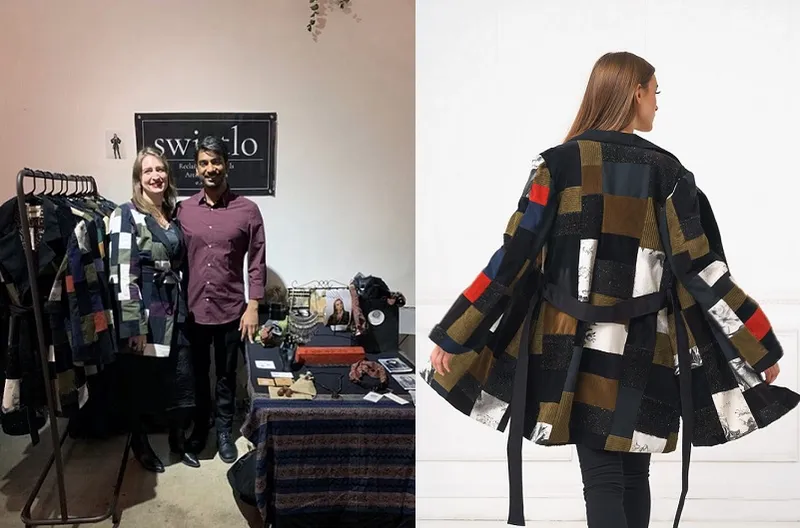
I wish I precisely knew to what extent things have changed here since the coronavirus outbreak, but the lockdown is so strict that we really can’t go anywhere outside our neighborhood. However, every night when we take a walk around our society, I smell the same smoke and the strong spices cooking that captivated me when I first landed here in 2016. It is a warm and comforting olfactory memory that says in such a simple way, life is going on!
Early years
I grew up in a neighbourhood surrounded by farms in Pennsylvania, with my parents and little brother. Farms always fascinated me; our family in Poland has an organic honeybee farm three hours from Warsaw. “Swiatlo” actually means “light, to illuminate” in Polish, as an ode to my matrilineal heritage.
My great grandfather Ignatz Barbaryka came to America to sell a horse in the early 1910s only to get stuck there when the country closed its borders due to WW1. No ships in, no ships out! He ended up marrying in the US, becoming an accidental immigrant, and inadvertently finding a better life for himself.
I often feel the same nowadays; I wonder what he’d think of me moving to India. Now living in Delhi, I love it here, but I do miss the expansive nature and life energy of farmland. I have plans to return to that way of living one day, likely further south of here.
Since the early 1960s, Pennsylvania has had pretty strong hippie communities, and cultural shifts during the Vietnam War period. ‘Om’ tapestries and patchwork dresses next to Beatles and Hendrix posters litter small storefronts here and there. The 1970s’ rock and sandalwood incense creep onto the sidewalk and guide you inside.

With my mother, in Manhattan during Christmas
Love and peace signs on the walls and Ganesh idols behind the cash registers - Indian influences in northeastern American culture can be seen almost everywhere, with restaurants, temples, and ‘Little Indias’ in every city as many Indian people migrate to metropolitan areas for school or work. We would drive by an Indian event in Pittsburgh from time to time, their joie de vivre and wonderfully colourful clothing always fascinated me.
I had been sewing my own clothing designs since the age of 13, and like many small-town kids, I dreamt of moving to the big city, New York, to be surrounded by creative energy. And nowhere in the world is like New York.
I studied fashion at Parsons, experimenting with patternmaking and mixing together colourful old clothes from the Goodwill. Later, I joined the industry as a technical designer for Kenneth Cole and Ralph Lauren. The goal was always entrepreneurship after industry experience, but what exactly that would be I wasn’t sure.
One day, in 2015, a friend gave me a gorgeous blockprinted cloth from Pakistan. An internet search revealed it was ajrakh, a spiritual Sindhi textile, dating back thousands of years. I ordered more online from India, and its arrival smelled like sweet smoke and herbs. I held the fabric to my face while looking at Hindi-scripted names of places on Google Maps.
At a temp tech job later, I heard a story told too casually about a man in a Hong Kong denim factory falling into a vat of chemicals. He was okay but his pants had burned off. Why are we using such chemicals, especially to make ten-thousand-pieces per-style bulk orders? Why should a person making our clothes be in such danger?
I wanted to make clothes in a way that was purposeful, helpful, and non-toxic. Clean and fresh, like that block printed ajrakh.
Journey to India
So, India came to mind. In early 2016, I left for Ahmedabad to work with artisan fashion company Craftroots. I stayed for six months, falling madly in love with Indian culture and textiles. Supply-chain discovery was my main goal, so obviously agriculture was the first step. I tried to help with a short-staple organic cotton harvest in Kutch.
Picking cotton is very difficult, and the women on the farm did it with such incredible grace. Over time, we visited a lot of different craftspeople in their workspaces, including the blockprinting of naturally dyed ajrakh in Bhuj.
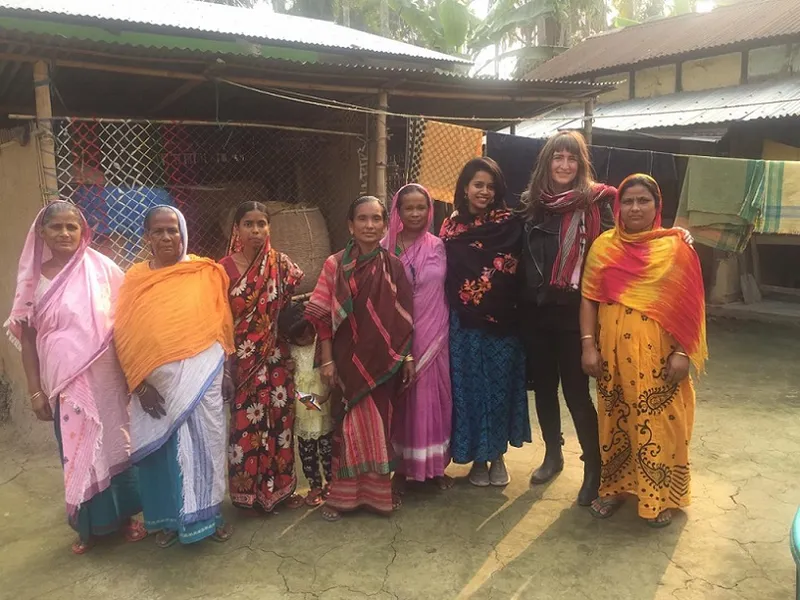
With Assamese weavers on a trip taken in collaboration with handloom fashion brand Atut
The innate understanding of how ecosystems should co-exist when making and disposing of things seen in indigenous craft was a life-changing experience. Handmaking is an act of devotion.
India was very different from the US, but I didn’t feel “culture shocked”. I felt incredibly comfortable and was quickly pushing through the busy streets and speaking in jagged basic Hindi.
The real shock was returning home. I’d heard the term “reverse culture shock” before, and it’s true – everything is the same, but you have changed. I went back to corporate fashion for a year and meticulously planned a return to study textile culture and the creation of clothing.
From Assam to Kerala to Tamil Nadu, back up to Gujarat and places in between, I visited people from different parts of the Indian fashion supply chain. What is being made there? How is it being made? How do people like to wear it and celebrate their culture? Celebrations in general are integral to Indian culture, and that is seen so clearly in their textiles.
In early 2019, I left NYC for Delhi for good, with samples I’d sewn to produce a formal collection for Swiatlo. The plan was to first visit blockprinter friends in Kutch and around Rajasthan for fabrics, and then find a stitching unit in Delhi to make the final pieces.
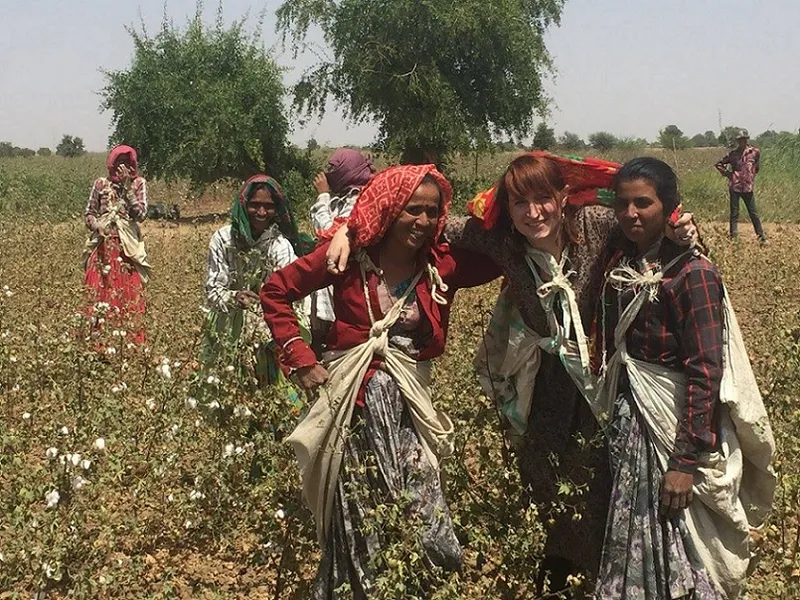
With cotton farmers in Kutch
Partnership
Before departing, I went on a Tinder drinks date at Monkey Bar in Vasant Kunj for fun and a few beers, that’s all I had expected. But Ashwath and I really hit it off! We talked for hours almost every night on the phone while I was travelling, really getting to know each other in such an “old school” way after meeting on a dating app.
We moved in together shortly after I returned to Delhi and got engaged a month after that. We set our wedding date with the pandit for March 22, 2020.
Ashwath and I launched Swiatlo’s first fashion collection together in New York for Holiday 2019. We had created one-of-a-kind patchwork wrap jackets from secondhand denims and corduroys, all fully lined with different blockprinted textiles and beautifully crafted by MasterG, a fantastic women’s training center and stitching unit.
We exhibited at markets in Manhattan, spoke at the Remake Brooklyn studio, and met a lot of wonderful people. The first collection was a success, and we were excited to return to Delhi and begin work for 2020.
COVID-19 outbreak and wedding
In January, someone told me there was a new flu in China. I got curious and began tracking it. Our wedding in Delhi was fast approaching; my parents, brother, cousins, and friends were all booked to travel.
After four years of my family asking me, “Why did you leave a job to go to India?” they were set to experience the answer for themselves. We had plans for the Taj Mahal, Jaipur, and Pondicherry, and our families were finally going to meet in person. Mom had her saree blouse stitched and dad asked how spicy the food would be!
India locked its borders on March 11 and all plans were cancelled, just a week before the wedding. We decided to continue only with a small religious ceremony. Our ceremony date, March 22, was declared the Janta Curfew, so it had to be at home.
My mom said – stream it! And our Big Digital Indian Wedding was born. His dad made a group for the screening on Facebook and we set up a live video. Our loved ones from all over the world were able to join in and watch our traditional Tamil ceremony, and it was surprisingly wonderful.
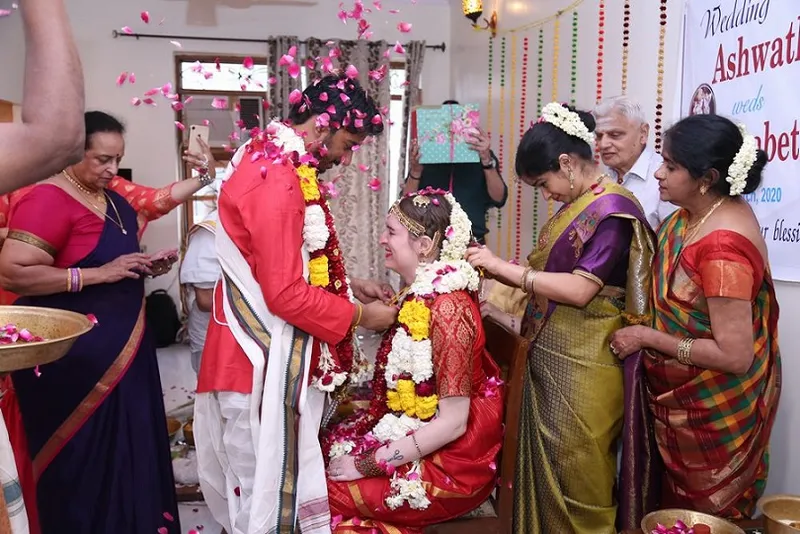
The lockdown
Two days later, India’s swift and strict lockdown began. We’ve been feeling alternately scared and grateful; keeping in touch with our loved ones and staying somewhat on top of the news without going too crazy. Meditating on our ever-evolving vision for the direction of our business, and life in general.
India’s sudden lockdown was a good move – but only for the people who have homes to lock down in.
We have been in a state of disbelief at the plight of the migrant labourers who walked very long distances to get to their homes. They weren’t even given a chance to catch a train or a bus. The fashion industry especially, as overseas giants cancel huge orders and abandon their people on this end of their supply chain. Workers were pushed out on the street suddenly with no pay and nowhere to go.
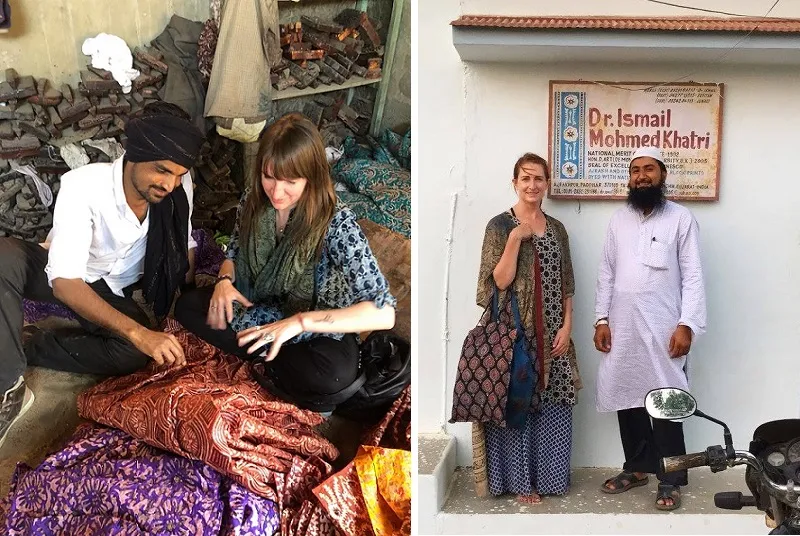
With Kuldip of Kutch Adventures India visiting artisan Anwar Khatri's batik studio (L); Sufiyan Khatri, ajrakh blockprint artisan in Ajrakhpur (R)
Community efforts
We asked around and found some really amazing people on the ground, helping these folks who were left behind. They include Care India locally in Delhi and Manav Sadhna in Ahmedabad. We’ve given what is possible for us and hopefully others can as well! No amount is too small, even one dollar can buy vegetables for someone.
Our friend runs a volunteer organisation, Volunteers Collective, which is feeding people and providing medicines to folks pushed out of the AIIMS hospital to make room for COVID-19 patients. Another friend informally offered on Facebook to assist anyone unable to leave their home, and we volunteered for our area.
From what I can see, it’s small community grassroots endeavors that are really helping through all of this. That’s the culture here in India – even someone who has only one piece of bread will break his in half to share with his neighbour.
People feel very compelled to take things into their own hands when any problem arises, and COVID-19 has been the same. Clusters of citizens have been organising distribution of food and supplies to those stuck on the street. Young engineers in Bengaluru have devised a low-cost portable ventilator, and scientists around the country have developed low-cost testing kits.
These very important things are crafted from supplies all found within the country to remove dependence on imports. Everyone is proud to say these tests and ventilators are 100 percent Made in India, including me! The innovation seen in India has always impressed and inspired me, especially now during the COVID-19 fight.
Now, we barely leave our apartment complex in Vasant Kunj. The vegetable cart still comes here, and we take walks from time to time. Everyone here is great with social distancing properly followed. There is a general feeling of us all being in this together as we exchange quick glances before moving to opposite sides of the pathway.
The airport is only 15 minutes away. We used to hear airplanes all day. Now maybe one or two commercial flights go by, but otherwise it’s just birds, wind, and stir-crazy kids laughing on rooftops. The days have begun to blend together, and I am regularly wondering what we will do once the lockdown lifts, what will life be like?
Work from home
Luckily, Swiatlo is small. I’ve aimed at a steady slow growth for the company, so we invested modestly in her development and didn’t take any huge risks. We have not yet taken any full-time employees. We have a network of freelancers we work with on a project basis. A graphic designer who helped us tweak our logo last year, a photographer who does our ecommerce shoots, and stitching units which make our pieces.
We might take a remote intern soon. Our production orders are on hold right now with both units, and they will continue once it’s safe to go back to the studio. We had some talks with shops in NYC earlier in the year to stock Swiatlo, and had planned to present our 2020 collection there in June.
Now, we don’t know when that will be or when we will be able to return to the US (we had flight tickets for late May, but they’ve been cancelled). Going after the Indian market wasn’t something we planned to do until we’d finalised more stockists in New York – but due to COVID-19 we have to completely reconsider our plans.
While working from home, I’ve been focussing on community and impact. Our mission in India goes beyond Swiatlo. Last year, I began managing production and supply chain for overseas brands who want to create mindfully and transparently here. Researching and building supply chains in India, especially with handmakers and natural fabrics, has its own share of beauty and challenges.
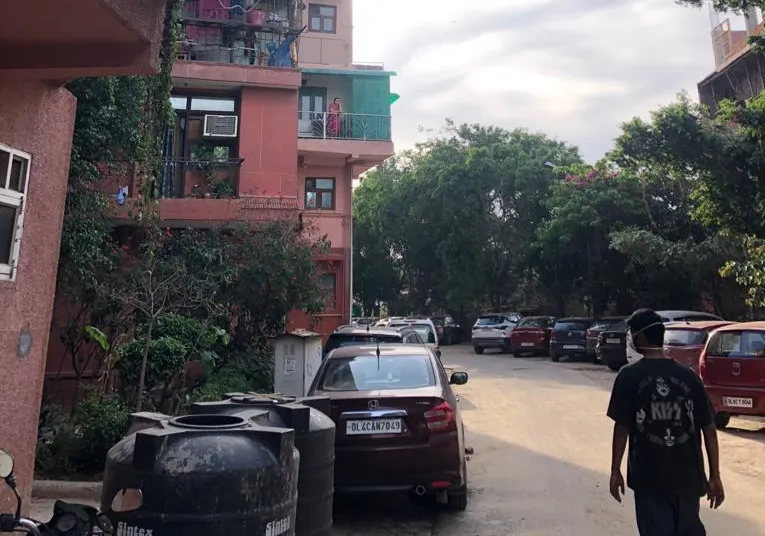
Neighbourhood in Vasant Kunj
I love being able to share this work with others, as Swiatlo is very young and only makes a small impact on its own. For brands who wish to produce responsibly with an understanding of export quality garments, we are here on the ground to monitor the labour, source appropriate fabrics, and ensure all items are delivered on time.
Until we can get back out there, our days are full of webinars, keeping in touch with our network, and planning future research trips. I have a lot of questions about organic cotton, banana silk, and other natural fibers grown and processed here so we are planning an exploratory visit to Tamil Nadu.
I have also been planning some artisan “slow travel” experiences with local friends in the tourism industry who I’ve known for years. At the end of the day, it’s about building community and trust within the supply chain, from agriculture to handmakers to the designers and the folks who wear the final garments as well.
Coping: a tale of two countries
I think about home a lot. I wonder when I’ll be able to see my family again. Through all the ups and downs of the past few years, travelling to so many random places, I felt confident that “no matter what, I can always go home”.
What about when flights are stopped? Like everyone else, I never could have imagined what has happened since COVID-19 appeared. The cracks we are seeing in our societies, and the people who are jumping up to change them. How quickly so much has changed.
It does not seem like the US federal government is handling this well, but that did not surprise me. Individual states have been banding together in clusters around the country and implementing their own policies and lockdowns.
Thank God my parents are in Pennsylvania, a state aligning with the lockdown of Andrew Cuomo’s New York. If they were in the south of the US right now, I’d be very concerned as many folks there don’t seem to take COVID-19 seriously. I still worry of course, but they are able to work from home and we speak every other day.
Mom and I love to just talk smack about the situation together - “can you believe this politician said that? And what about the testing kits??” Normally we wouldn’t be so “negative,” but I think we feel better after letting out some steam. This whole ordeal has actually brought us closer; we used to speak a lot less back in the “normal fast life” days.
I really want to say I’ve been ‘Eating My Greens’ and ‘Doing Home Workouts’ but I absolutely have not been doing those things and most days I feel rather raggedy. I’m really focussed on work and often I think a lot of fear is behind my obsession to always be at my computer, catch every webinar, plan every Insta post, and jump on constant calls.
The uncertainty of our world is killing me a little, although I don’t really tell people that. I’m one of the lucky ones with a home and food, so I hesitate to share my small struggles. When the Indian government gave us 21 days last month, I could wrap my mind around it, but now it’s just an unknown and I’m feeling anxious.
Last week, I began my Vipassana meditation practice again, which has been really helpful. I would definitely recommend any form of meditation for anyone to help us through this crisis.

Ashwath and Liz
The road ahead
However, now is the time for all of us to remain hopeful and do what we can to get each other through this. We have an opportunity to recognise issues like failed healthcare systems and financial inequality in our communities, and come together to do something about it.
Personally, I see this as a chance for us to make some real change in the polluting and abusive fashion industry. We need labour policies which support all people in our supply chains, and we need to slow the calendar speed to reduce excess production and wastefulness. Whatever you feel strongly about – call it out! Others likely feel the same.
At first I had slowed down and absorbed the shock of things. Now I am very immersed in building our work – so I am not sure if ‘slow down’ has stuck in a physical sense, but mentally I’ve been learning to recognise when we need to relax.
Our sense of community has strengthened as regular phone and video calls have increased immensely. I’d like us to continue keeping our loved ones close and remaining aware of how our personal choices affect the collective.
I think my biggest take-away from this crisis would be how all of us found strength within each other. It takes a village. I hope globally more people take the time to know their neighbours and participate in their communities to build the more compassionate and loving post COVID-19 world we would all like to see.
Edited by Megha Reddy










